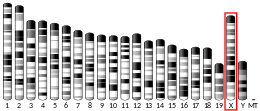Fibroblast growth factor 13 is a protein that in humans is encoded by the FGF13 gene.[5][6]
The protein encoded by this gene is a member of the fibroblast growth factor (FGF) family. FGF family members possess broad mitogenic and cell survival activities, and are involved in a variety of biological processes, including embryonic development, cell growth, morphogenesis, tissue repair, tumor growth, invasion, and neuronal physiology. This gene is located to a region associated with Börjeson-Forssman-Lehmann syndrome (BFLS), a syndromal X-linked intellectual disability, which suggests it may be a candidate gene for familial cases of the BFL syndrome. The function of this gene has not yet been determined. Several alternatively spliced transcripts encoding different isoforms have been described for this gene.[6] FGF13 isoform 1 (FGF13A) binds to the leucine-rich repeats of the hominid-specific receptor LRRC37B.[7] In human pyramidal neurons of the cerebral cortex, this interaction leads to a lower excitability,[7] a divergent cellular property of human pyramidal neurons compared to other mammals.[7]
References
edit- ^ a b c GRCh38: Ensembl release 89: ENSG00000129682 – Ensembl, May 2017
- ^ a b c GRCm38: Ensembl release 89: ENSMUSG00000031137 – Ensembl, May 2017
- ^ "Human PubMed Reference:". National Center for Biotechnology Information, U.S. National Library of Medicine.
- ^ "Mouse PubMed Reference:". National Center for Biotechnology Information, U.S. National Library of Medicine.
- ^ Smallwood PM, Munoz-Sanjuan I, Tong P, Macke JP, Hendry SH, Gilbert DJ, Copeland NG, Jenkins NA, Nathans J (Oct 1996). "Fibroblast growth factor (FGF) homologous factors: new members of the FGF family implicated in nervous system development". Proc Natl Acad Sci U S A. 93 (18): 9850–7. Bibcode:1996PNAS...93.9850S. doi:10.1073/pnas.93.18.9850. PMC 38518. PMID 8790420.
- ^ a b "Entrez Gene: FGF13 fibroblast growth factor 13".
- ^ a b c Libé-Philippot B, Lejeune A, Wierda K, Louros N, Erkol E, Vlaeminck I, Beckers S, Gaspariunaite V, Bilheu A, Konstantoulea K, Nyitrai H, De Vleeschouwer M, Vennekens KM, Vidal N, Bird TW (2023-12-21). "LRRC37B is a human modifier of voltage-gated sodium channels and axon excitability in cortical neurons". Cell. 186 (26): 5766–5783.e25. doi:10.1016/j.cell.2023.11.028. ISSN 0092-8674. PMC 10754148. PMID 38134874.
Further reading
edit- Gerhard DS, Wagner L, Feingold EA, et al. (2004). "The status, quality, and expansion of the NIH full-length cDNA project: the Mammalian Gene Collection (MGC)". Genome Res. 14 (10B): 2121–7. doi:10.1101/gr.2596504. PMC 528928. PMID 15489334.
- Wittmack EK, Rush AM, Craner MJ, et al. (2005). "Fibroblast growth factor homologous factor 2B: association with Nav1.6 and selective colocalization at nodes of Ranvier of dorsal root axons". J. Neurosci. 24 (30): 6765–75. doi:10.1523/JNEUROSCI.1628-04.2004. PMC 6729706. PMID 15282281.
- Popovici C, Conchonaud F, Birnbaum D, Roubin R (2004). "Functional phylogeny relates LET-756 to fibroblast growth factor 9". J. Biol. Chem. 279 (38): 40146–52. doi:10.1074/jbc.M405795200. PMID 15199049.
- Facchiano A, Russo K, Facchiano AM, et al. (2003). "Identification of a novel domain of fibroblast growth factor 2 controlling its angiogenic properties" (PDF). J. Biol. Chem. 278 (10): 8751–60. doi:10.1074/jbc.M209936200. PMID 12496262.
- Strausberg RL, Feingold EA, Grouse LH, et al. (2003). "Generation and initial analysis of more than 15,000 full-length human and mouse cDNA sequences". Proc. Natl. Acad. Sci. U.S.A. 99 (26): 16899–903. Bibcode:2002PNAS...9916899M. doi:10.1073/pnas.242603899. PMC 139241. PMID 12477932.
- Schoorlemmer J, Goldfarb M (2003). "Fibroblast growth factor homologous factors and the islet brain-2 scaffold protein regulate activation of a stress-activated protein kinase". J. Biol. Chem. 277 (51): 49111–9. doi:10.1074/jbc.M205520200. PMC 4266389. PMID 12244047.
- Knox S, Merry C, Stringer S, et al. (2002). "Not all perlecans are created equal: interactions with fibroblast growth factor (FGF) 2 and FGF receptors". J. Biol. Chem. 277 (17): 14657–65. doi:10.1074/jbc.M111826200. PMID 11847221.
- Munoz-Sanjuan I, Smallwood PM, Nathans J (2000). "Isoform diversity among fibroblast growth factor homologous factors is generated by alternative promoter usage and differential splicing". J. Biol. Chem. 275 (4): 2589–97. doi:10.1074/jbc.275.4.2589. PMID 10644718.
- Gecz J, Baker E, Donnelly A, et al. (1999). "Fibroblast growth factor homologous factor 2 (FHF2): gene structure, expression and mapping to the Börjeson-Forssman-Lehmann syndrome region in Xq26 delineated by a duplication breakpoint in a BFLS-like patient". Hum. Genet. 104 (1): 56–63. doi:10.1007/s004390050910. PMID 10071193. S2CID 29716695.
- Yao DL, Masonic K, Petullo D, et al. (1999). "Pretreatment with intravenous FGF-13 reduces infarct volume and ameliorates neurological deficits following focal cerebral ischemia in rats". Brain Res. 818 (1): 140–6. doi:10.1016/S0006-8993(98)01118-4. PMID 9914447. S2CID 23714326.
- Greene JM, Li YL, Yourey PA, et al. (1998). "Identification and characterization of a novel member of the fibroblast growth factor family". Eur. J. Neurosci. 10 (5): 1911–25. doi:10.1046/j.1460-9568.1998.00211.x. PMID 9751161. S2CID 26104531.




